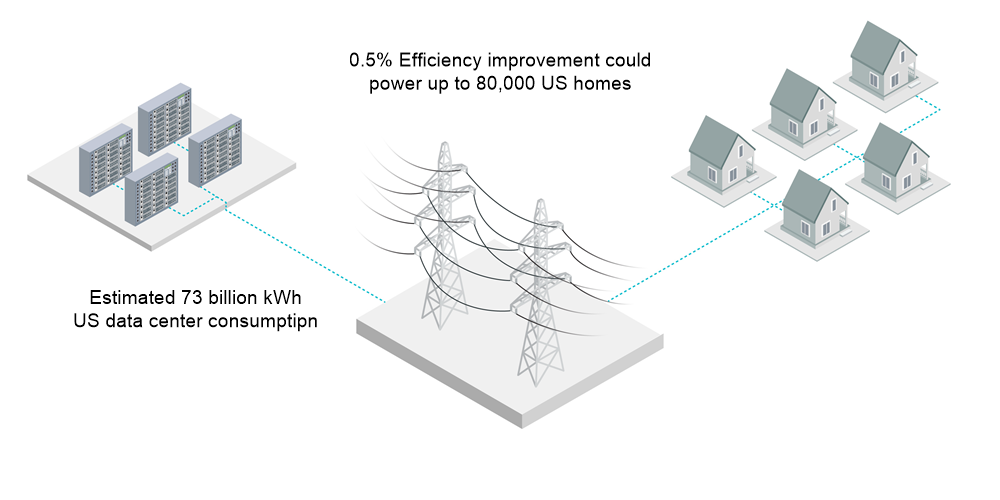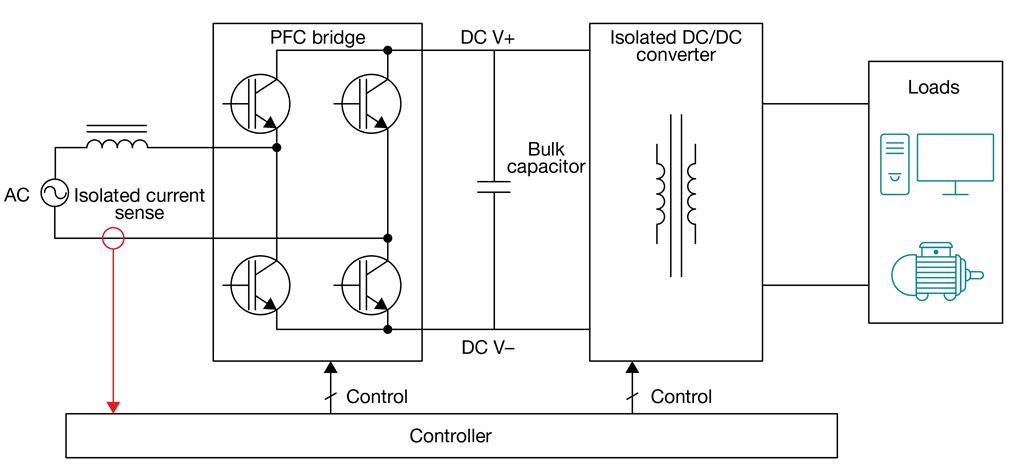SBOA401A June 2020 – March 2022 TMCS1100 , TMCS1100-Q1 , TMCS1101 , TMCS1101-Q1 , TMCS1107 , TMCS1107-Q1 , TMCS1108 , TMCS1108-Q1
1 Improving Energy Efficiency For Today’s Systems
As high-voltage systems increase in numbers and power levels, there is a commensurate increase in energy consumption of equipment connected to or charged by the power grid. Regulation, energy costs, and technical limitations such as power density force these systems to become more efficient and use energy more intelligently. Industrial automation equipment, electric battery packs in automobiles and even home appliances waste significant energy during power conversion from the AC grid input to DC loads or energy storage elements.
Even minor improvements in power-delivery systems can have a significant effect considering the scale of modern power systems. For example, server and data centers consume as much as 23% of all U.S. electricity consumption, yet studies show an overall efficiency of approximately 65%. Improving the efficiency of these systems even 0.5% with more efficient power conversion and smarter load monitoring could save up to 850 million kWh, equivalent to the energy usage of almost 80,000 households annually, as Figure 1-1 shows.
 Figure 1-1 Efficiency Improvements Could Save
Significant Energy
Figure 1-1 Efficiency Improvements Could Save
Significant EnergyPower systems such as uninterruptable power supplies (UPS) or industrial AC/DC converters use switching converter topologies to optimize efficiency while converting energy from the AC grid. For these systems, isolated current measurements are required for diagnostic information and converter control loops such as power factor correction (PFC) circuits. Figure 1-2 highlights a PFC topology that requires an isolated current measurement directly on the AC input current. Because the current measurement controls the switching converter, the accuracy and lifetime stability of these current measurements can significantly impact the overall efficiency and power factor of the converter.
 Figure 1-2 PFC Converter Topology With Isolated
Current Sensing
Figure 1-2 PFC Converter Topology With Isolated
Current SensingHistorically, isolated current-sensing measurements have a high cost-performance trade-off, requiring significantly more expense for equipment manufacturers to make high-precision measurements. Hall-effect current sensors provide the simplest implementation with no external components and an improved cost structure, but are typically not capable of providing low drift measurements over temperature.
Isolated shunt-based and closed-loop magnetic devices can provide a higher level of accuracy, but require more PCB space and external components, and are more expensive. The TMCS1100 and TMCS1101 from Texas Instruments (TI) couple the ease of use and low solution cost of a Hall-effect current sensor with a zero-drift precision signal-chain architecture to enable < 1% total error measurements and improved isolation quality. These innovations improve upon the typical negatives of Hall-effect current sensors, while retaining their key positive attributes. Table 1-1 highlights relative strengths and weaknesses of multiple isolated current sensing technologies.
|
Isolated Shunt-based |
Closed-loop Magnetic |
In-package Hall-Effect Sensor |
||
|---|---|---|---|---|
|
Typical Hall-Effect Device |
TMCS1100 Family |
|||
|
Solution size |
– |
– – |
+ + |
+ + |
|
External components needed |
1 to 3 |
2 to 5 |
0 |
0 |
|
Solution cost |
– |
– – |
+ + |
+ + |
|
Accuracy |
+ + |
+ + |
– |
+ |
|
Offset and sensitivity drift |
+ + |
+ + + |
– – |
+ |
|
Insulation Lifetime |
+ + |
+ + |
– |
+ |
The 1-kW, 80 Plus Titanium, GaN CCM totem pole bridgeless PFC and half-bridge LLC reference design highlights the impact of such a high-precision sensor, where the TMCS1100 enables a small form factor design that achieves a power factor of 0.98 with > 99% efficiency. The thermal stability of the TMCS1100 in both sensitivity and offset drift contributes to a reduction in total harmonic distortion of as much as 5%.
The galvanic isolation of the TMCS1100 decouples the system from the AC grid and simplifies measurements on AC lines with no additional components while providing < 0.5% of measurement drift. This provides improved efficiency over a variety of load and environmental conditions in compact, high-power systems such as server or network power supplies. Because the grid infrastructure chain relies on multiple UPSs, conditioners and power-conversion steps, improvements in performance, and cost structure are compounded by each stage in the chain.